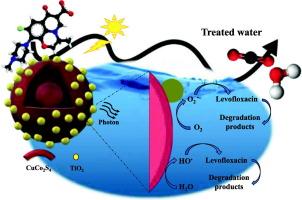高效处理制药污染物:关于可持续的黄入双壳 CuCo2S4@Bi 掺杂 TiO2 光催化剂性能和机理的综合研究
IF 6.7
2区 工程技术
Q1 ENGINEERING, CHEMICAL
引用次数: 0
摘要
二氧化钛的光催化潜力显著,具有良好的理化特性和氧化能力。然而,解决二氧化钛有限的光收集光谱问题对于实际应用至关重要。在此,我们提出了一种新方法,将通过元素掺杂实现的电子增强与 Z 型异质结下的分层多级构型相结合,以实现显著的光催化活性。我们采用醇助溶胶-凝胶法将铋原子掺入二氧化钛晶格中,形成了(3)Bi-TO 纳米粒子。分层介孔结构使(3)Bi-TO具有较大的SBET(83 m2/g),而铋的加入则产生了各种缺陷和中隙,从而改善了光收集并促进了电荷载流子分离。然后,利用一种简便的等电点介导退火技术,将这些缺陷和中隙封装到氧化烷基 CuCo2S4(YS-CCS)黄壳结构的外壳上,从而形成了一种 Z 型 YS-CCS@(3)BiTO 黄入双壳结构。紫外可见漫反射光谱(UV-Vis DRS)、光致发光(PL)、电化学阻抗光谱(EIS)和瞬态光电流表明,YS-CCS@(3)Bi-TO 蛋黄双壳异质结同时增强了光收集能力、提高了光子利用率、延长了电荷载流子寿命并提高了导电性。在优化 YS-CCS 的质量负载(40 wt%)和操作参数(pH 值:5,催化剂用量:1.0 g/L,浸出液浓度:1.0 g/L)后,结果表明1.0克/升,左氧氟沙星(LFC)浓度为50毫克/升)后,YS-CCS的催化活性达到了预期效果:YS-CCS@(3)Bi-TO在全LFC光降解中表现出显著的光催化性能,在动力学上分别比YS-CCS和(3)Bi-TO以及不含Bi的TO高29.9倍、4.7倍和11.3倍。YS-CCS@(3)Bi-TO的稳健性体现在连续六个循环的持续效率、可忽略不计的金属浸出以及通过 XRD 分析确认的稳定性。此外,该催化剂在长达 5 小时的 LFC 矿化和 6 小时的实际废水处理中表现出色,证明了催化剂设计的成功,具有潜在的工业应用前景。最后,这种设计和策略有望开发出具有几何构型和电子特性的纳米材料,从而增强光催化活性。本文章由计算机程序翻译,如有差异,请以英文原文为准。

Highly efficient treatment of pharmaceutical contaminants: A comprehensive study on the performance and mechanism of sustainable yolk-in-double-shelled CuCo2S4@Bi-doped TiO2 photocatalyst
The photocatalytic potential of TiO2 is notable, with promising physiochemical properties and oxidation capabilities. Nevertheles, addressing the limited light-harvesting spectrum of TiO2 is crucial for practical applications. Herein, we propose a novel approach combining electronic enhancement through elemental doping and a hierarchical multi-level configuration under Z-scheme heterojunction to achieve remarkable photocatalytic activity. Using the alcohol-assisted sol-gel method, we incorporated bismuth atoms into the TiO2 lattice to form (3)Bi-TO nanoparticles. While the hierarchical mesoporous texture provided (3)Bi-TO with a large SBET (83 m2/g), the Bi incorporation conferred various defects and mid-gaps to improve light-harvesting and promote charge carrier separation. These were then encapsulated onto the exterior shell of alkoxide-based CuCo2S4 (YS-CCS) yolk-shell structures using a facile isoelectric point-mediated annealing technique, creating a Z-scheme YS-CCS@(3)Bi-TO yolk-in-double-shell architecture. The yolk-in-double-shelled YS-CCS@(3)Bi-TO heterojunction simultaneously enhanced light-harvesting, improved photon utilization, prolonged charge carrier lifetime, and advanced conductivity, as indicated by the UV–vis diffuse reflectance spectra (UV–Vis DRS), photoluminescence (PL), electrochemical impedance spectroscopy (EIS), and transient photocurrent. Upon optimizing the mass-loading of YS-CCS (40 wt%) and operational parameters (pH: 5, catalyst dosage: 1.0 g/L, and levofloxacin (LFC) concentration: 50 mg/L), the YS-CCS@(3)Bi-TO exhibited remarkable photocatalytic performance in total LFC photodegradation, which was 29.9, 4.7, and 11.3 folds kinetically higher than that of the YS-CCS and (3)Bi-TO, and Bi-free TO, respectively. The robustness of YS-CCS@(3)Bi-TO was demonstrated by sustained efficiency over six consecutive cycles, negligible metal leaching, and confirmed stability through XRD analysis. Additionally, its outstanding performance in long-time LFC mineralization over 5 h and real wastewater treatment over 6 h demonstrated a successful catalyst design with potential industrial applications. Finally, this design and strategy hold promises for developing nanomaterials with geometrical configuration and electronic properties in synergy for enhanced photocatalytic activity.
求助全文
通过发布文献求助,成功后即可免费获取论文全文。
去求助
来源期刊

Journal of water process engineering
Biochemistry, Genetics and Molecular Biology-Biotechnology
CiteScore
10.70
自引率
8.60%
发文量
846
审稿时长
24 days
期刊介绍:
The Journal of Water Process Engineering aims to publish refereed, high-quality research papers with significant novelty and impact in all areas of the engineering of water and wastewater processing . Papers on advanced and novel treatment processes and technologies are particularly welcome. The Journal considers papers in areas such as nanotechnology and biotechnology applications in water, novel oxidation and separation processes, membrane processes (except those for desalination) , catalytic processes for the removal of water contaminants, sustainable processes, water reuse and recycling, water use and wastewater minimization, integrated/hybrid technology, process modeling of water treatment and novel treatment processes. Submissions on the subject of adsorbents, including standard measurements of adsorption kinetics and equilibrium will only be considered if there is a genuine case for novelty and contribution, for example highly novel, sustainable adsorbents and their use: papers on activated carbon-type materials derived from natural matter, or surfactant-modified clays and related minerals, would not fulfil this criterion. The Journal particularly welcomes contributions involving environmentally, economically and socially sustainable technology for water treatment, including those which are energy-efficient, with minimal or no chemical consumption, and capable of water recycling and reuse that minimizes the direct disposal of wastewater to the aquatic environment. Papers that describe novel ideas for solving issues related to water quality and availability are also welcome, as are those that show the transfer of techniques from other disciplines. The Journal will consider papers dealing with processes for various water matrices including drinking water (except desalination), domestic, urban and industrial wastewaters, in addition to their residues. It is expected that the journal will be of particular relevance to chemical and process engineers working in the field. The Journal welcomes Full Text papers, Short Communications, State-of-the-Art Reviews and Letters to Editors and Case Studies
 求助内容:
求助内容: 应助结果提醒方式:
应助结果提醒方式:


